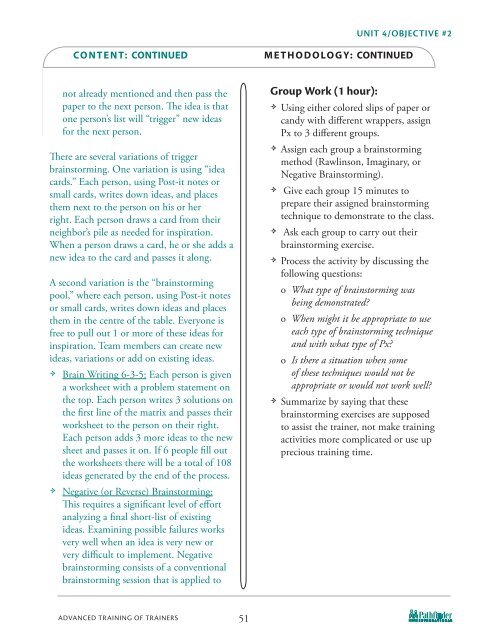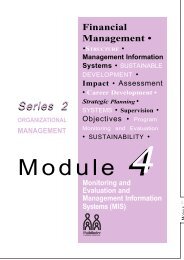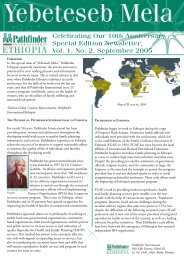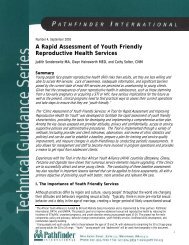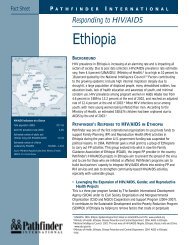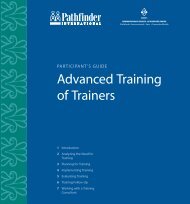Advanced Training of Trainers - Pathfinder International
Advanced Training of Trainers - Pathfinder International
Advanced Training of Trainers - Pathfinder International
Create successful ePaper yourself
Turn your PDF publications into a flip-book with our unique Google optimized e-Paper software.
CO N T E N T: CONTINUED<br />
not already mentioned and then pass the<br />
paper to the next person. The idea is that<br />
one person’s list will “trigger” new ideas<br />
for the next person.<br />
There are several variations <strong>of</strong> trigger<br />
brainstorming. One variation is using “idea<br />
cards.” Each person, using Post-it notes or<br />
small cards, writes down ideas, and places<br />
them next to the person on his or her<br />
right. Each person draws a card from their<br />
neighbor’s pile as needed for inspiration.<br />
When a person draws a card, he or she adds a<br />
new idea to the card and passes it along.<br />
A second variation is the “brainstorming<br />
pool,” where each person, using Post-it notes<br />
or small cards, writes down ideas and places<br />
them in the centre <strong>of</strong> the table. Everyone is<br />
free to pull out 1 or more <strong>of</strong> these ideas for<br />
inspiration. Team members can create new<br />
ideas, variations or add on existing ideas.<br />
N Brain Writing 6-3-5: Each person is given<br />
a worksheet with a problem statement on<br />
the top. Each person writes 3 solutions on<br />
the first line <strong>of</strong> the matrix and passes their<br />
worksheet to the person on their right.<br />
Each person adds 3 more ideas to the new<br />
sheet and passes it on. If 6 people fill out<br />
the worksheets there will be a total <strong>of</strong> 108<br />
ideas generated by the end <strong>of</strong> the process.<br />
N Negative (or Reverse) Brainstorming:<br />
This requires a significant level <strong>of</strong> effort<br />
analyzing a final short-list <strong>of</strong> existing<br />
ideas. Examining possible failures works<br />
very well when an idea is very new or<br />
very difficult to implement. Negative<br />
brainstorming consists <strong>of</strong> a conventional<br />
brainstorming session that is applied to<br />
AdvAnced TrAining <strong>of</strong> TrAiners<br />
51<br />
UNIT 4/OBJECTIVE #2<br />
m E T h O D O lO g y: CONTINUED<br />
Group Work (1 hour):<br />
N Using either colored slips <strong>of</strong> paper or<br />
candy with different wrappers, assign<br />
Px to 3 different groups.<br />
N Assign each group a brainstorming<br />
method (Rawlinson, Imaginary, or<br />
Negative Brainstorming).<br />
N Give each group 15 minutes to<br />
prepare their assigned brainstorming<br />
technique to demonstrate to the class.<br />
N Ask each group to carry out their<br />
brainstorming exercise.<br />
N Process the activity by discussing the<br />
following questions:<br />
o What type <strong>of</strong> brainstorming was<br />
being demonstrated?<br />
o When might it be appropriate to use<br />
each type <strong>of</strong> brainstorming technique<br />
and with what type <strong>of</strong> Px?<br />
o Is there a situation when some<br />
<strong>of</strong> these techniques would not be<br />
appropriate or would not work well?<br />
N Summarize by saying that these<br />
brainstorming exercises are supposed<br />
to assist the trainer, not make training<br />
activities more complicated or use up<br />
precious training time.


